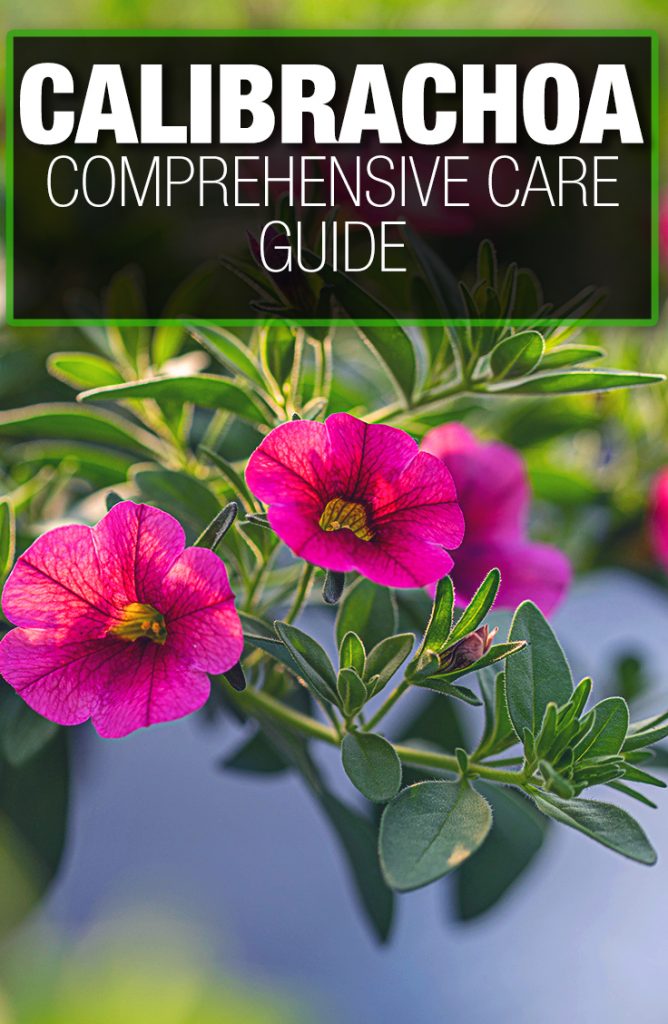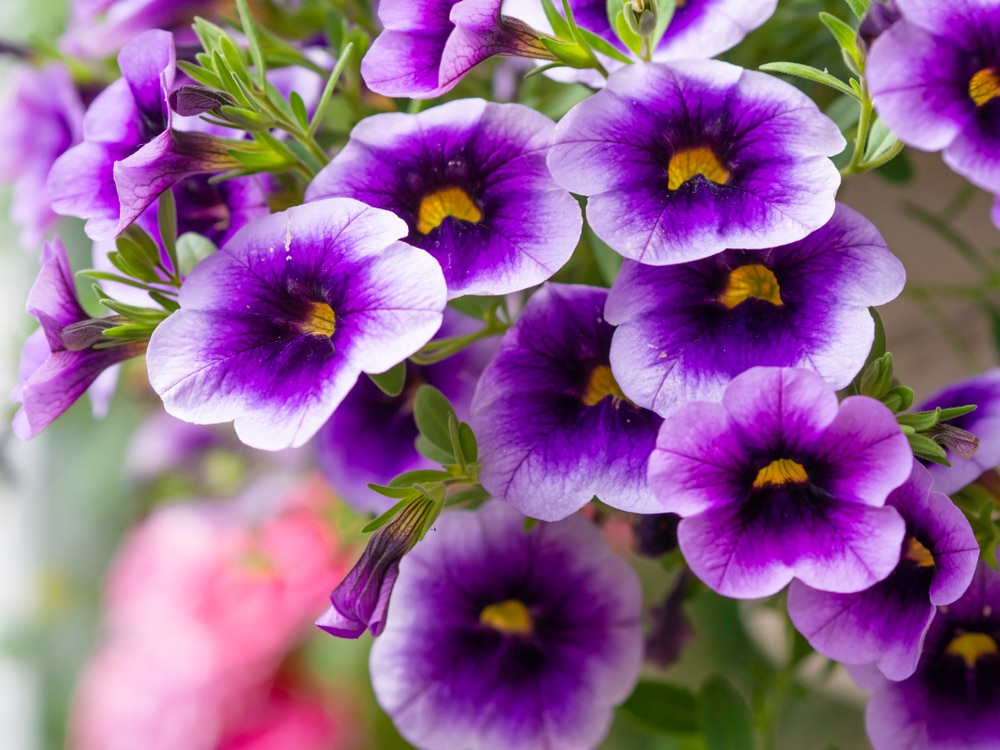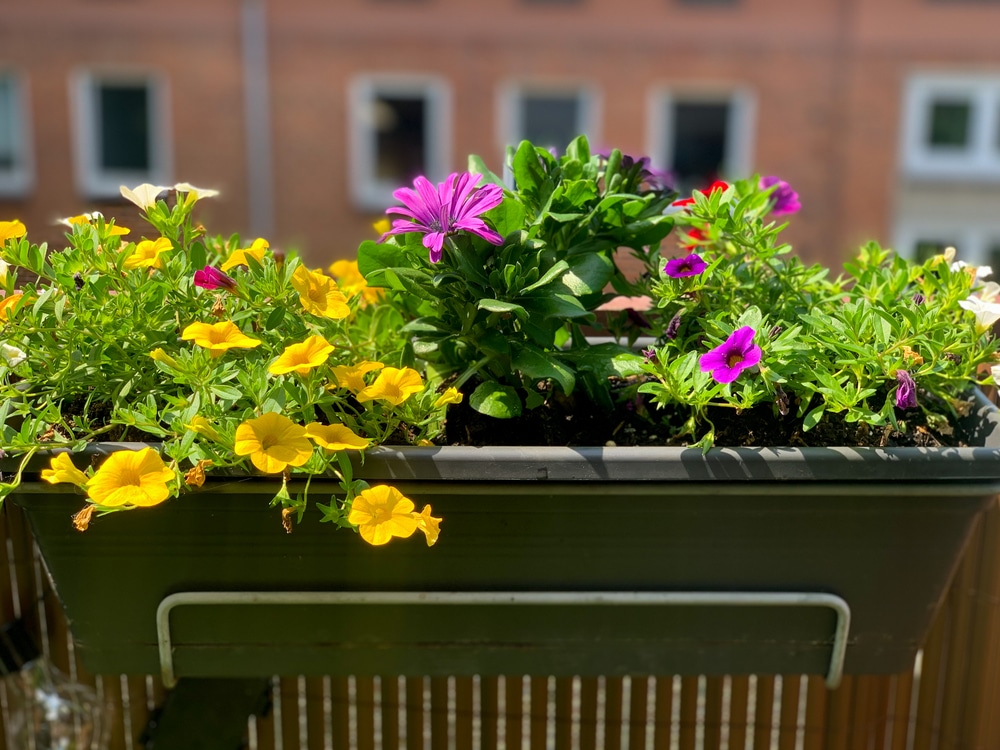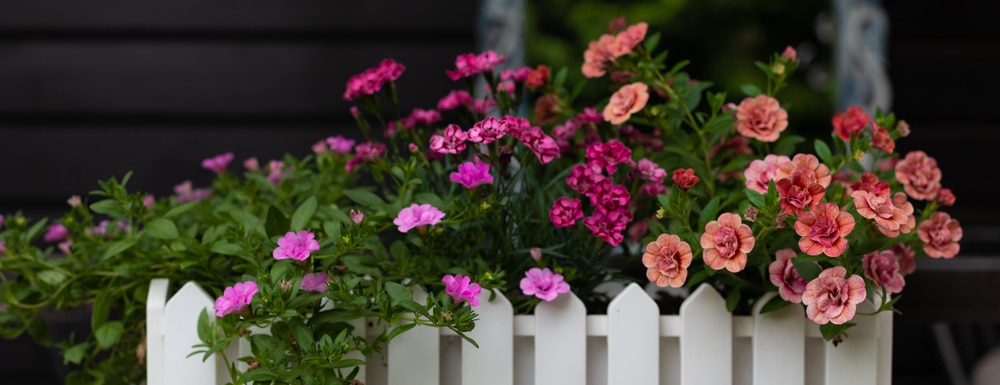Calibrachoa, also known as Million Bells or Superbells, look like miniature petunias, but they are not petunias. They are related to petunias but they are their own species.
These sweet little plants are perfect for container gardens, porch pots, patios, and hanging baskets. They are native to South America and are hardy in zones 9 to 11, but most gardeners grow calibrachoas as summer annuals.
The flowers may be small, but they can pack a punch. Their easy-care, mounding, rambling habits, and non-stop blooms that bring a pop of cheerful color have made these plants a gardening favorite for decades. Million Bells should be considered for any summer garden design.
There are several varieties, which offer a wide array of colors – red, white, yellow, pink, blue, purple, and orange are most common. Most are between 6 and 12 inches tall, with a spread from 9 to 20 inches wide.
Make sure to also take care of the trees on your property. Our Chinese elm tree care guide will teach you everything you need to know about how to raise them properly!

Design Ideas
Plant Million Bells where they can be seen! They can be planted in the garden if the soil drains well, but their small flowers might be lost to view. Keep them at the front of the bed, or plant them as a border. They would work best in a flower bed with other small garden favorites like ageratum, petite marigolds, or angelonia.
Calibrachoa are spectacular when used in hanging baskets and containers. Their dainty size is just adorable in a container on your front step, or try a series of flower pots going up the stairs. They are also perfect for window boxes. Combine them with trailing petunia plants, bacopa, or lobelia in a hanging basket using a complementary or contrasting color.

Different Varieties
There are many varieties of calibrachoa plants, and calibrachoa goes by many names – Million Bells, Superbells, ‘petunia Million Bells,” and even mini petunias. With all these different names, how do you keep them straight? And, there is a miniature petunia – Littletunia – to make it even more confusing!
To help you make sense of it all, here’s a list of a few of our favorite varieties with tips on how to best place them in your garden.
Million Bells
Million Bells is the hybrid that gave the plant its common name. This series has won many awards and has been beloved by gardeners for decades. The trailing varieties of million bells can be 48 inches long!
Size: 8-10 inches tall
Habit: mounding and trailing forms
Colors: red, white, pink, blue, orange
Gardening ideas: Try these plants spilling out over a garden wall, or out of window boxes, or in one giant pot in front of your home.
Superbells
This popular series has bi-color varieties and some double flowered blooms, too.
Size: 8-12 inches tall, 12-24 inches wide
Habit: mounding and rambling
Colors: purples, pink, yellow, blue, orange, red, white
Gardening ideas: Mix 3 high-contrast ( think yellow, purple, orange) hues together in hanging baskets, window boxes, or containers to give a pop of color to your home.

Noa
Noa is a hybrid that can take a little frost, so they can get growing earlier in the spring. They look fantastic tumbling over the edges of pots.
Size: 6-12 inches high, 12-15 inches wide
Habit: mounded, semi-trailing
Colors: yellow, orange, red, pink, blue, purple, burgundy, lavender, white
Gardening ideas: Plant spring and fall containers with Noas, pansies, and other cool-weather plants. These are also good for growing in the ground as a border or at the front of a garden bed.
Celebration
Celebration has a dense form with long-lasting flowers in 15 gorgeous colors.
Size: 8-12 inches tall, 9-14 inches wide
Habit: compact, rambling
Colors: yellow, white, red, rose, orange, purples
Gardening ideas: Line your front steps with a series of pots, each pot can hold a different color.
Calitastic
Calitastic are compact and upright with large flowers with yellow centers.
Size: 8- 9 inches high, 9-14 inches wide
Habit: Upright, trailing
Colors: Blue, orange, fuschia, yellow, white, red, pinks, burgundy
Gardening ideas: The perfect choice for a hanging basket or a container. Calitastic looks great by itself or combine it with other annuals such as verbena or alyssum.
Chameleon
This new hybrid is causing lots of excitement. Changes in temperature and sun exposure cause changes in flower color, giving this series its name. Some blooms might have two or three different shades happening at the same time.
Size: 9-12 inches high, 12-16 inches wide
Habit: mounding
Colors: changing shades of blue, pink, and orange with yellow throats
Gardening ideas: This is a great stand-alone plant. Try a single variety in a basket or container to let these blooms show off.

If you are looking for an exotic plant to grow in your yard, consider planting elephant ear bulbs. Its unique foliage creates a perfect centerpiece.
How to Grow
With proper care, calibrachoa will bloom all season. Some varieties can take a light frost.
They grow best in full sun. Full sun encourages them to flower profusely, but they can be grown in partial shade. They like well-drained soil and frequent fertilizer applications. They need more frequent waterings than their cousin, the petunia.
If planting in pots, window boxes, or hanging baskets, then make sure to use a high-quality potting mix. Be sure the bag is labeled “potting mix,” not “potting soil.” Potting soil will be too heavy. Calibrachoas need to be planted in a well-drained medium. Heavy, wet soils can cause root rot.
If planting in the ground, wait until the danger of frost has passed and don’t plant until the soil has warmed up to avoid rot.
Care Guide
Caring for them is relatively simple. After meeting soil and light requirements, calibrachoa need water, fertilization, and grooming. The following tips can help your plants be the star of your garden.
First, they need a good watering protocol. Water well – deeply and thoroughly. These plants need a moist soil, but not a wet one. Don’t let your million bells dry out, but do allow them to dry down. The soil should feel like a damp sponge before you water again.
Calibrachoa are heavy feeders. Use a fertilizer designed to increase flowers – some are labeled as blossom-boosters – and one with iron will help keep the leaves bright green. High nitrogen will increase vegetative growth (leaves and stems), not flowers. If your home is in an area with alkaline water, your plants will benefit from an acidic fertilizer, such as Miracid.
If you want to use a slow-release fertilizer, recommended applications would be at planting, in early July, and a final application in early September.

FAQ
Do I Need to Deadhead?
Calibrachoa Million Bells are generally self-cleaning. That means the dead flowers fall off and not do not need to be cut off. However, like most annual plants, Million Bells will continue to look their best with the occasional trim throughout the summer, especially when they start to get leggy, with only a few flowers at the tips of their trailing stems.
Why is My Calibrachoa Dying?
Your plant may have root rot. This is the number one problem with million bells. And inconsistent watering can cause it.
If your plant has root rot, the plant’s leaves will look wilted and may even be brown and withered. This may make it seem like your calibrachoa needs more water, but it probably needs less! Allow the plant to dry down and decrease the watering frequency.
Do They Come Back Every Year?
That depends on where you live. Calibrachoa is perennial in USDA hardiness zones 9 to 11, so it will continue to grow through the winter. For those of us in cooler zones, calibrachoa performs as an annual.

Can I Propagate Cuttings?
Calibrachoa are easy to grow from cuttings. However, most varieties are trademarked and propagation might be restricted or prohibited. The plant tag will tell you if it’s okay to create new plants from cuttings.
You can save seeds from your plants for next year, but these plants may not come true. They might look nothing like the flower you remember from last summer, but you still could grow something pretty!
Can I Overwinter Them?
Yes, they can be overwintered indoors. Indoor care requirements are a little different than the care you provided in the garden.
Bring your plant indoors at the end of the season. You might want to pot it up in fresh soil. Trim back the stems and remove any spent flowers. This is a good time for a serious haircut.
Place the plant in a bright location, but not in full sun. Let it rest – you do not have to water as frequently as you did. Use liquid fertilizer every other week. A slow-release fertilizer can also be used, but apply only half the recommended rate. As the days grow longer and brighter, you can increase both water and fertilizer.
Watch for rot and insects such as aphids and spider mites. With luck and good care, your plant should make it until it’s time to bring it into the garden in the spring.



Good article, you might want to proofread it a little though
I have good success by layering has anyone else tried this?
This is a great propagation method for calibrachoas grown in the ground – they root very easily. For plants in containers and hanging baskets, propagation from cuttings is easier.